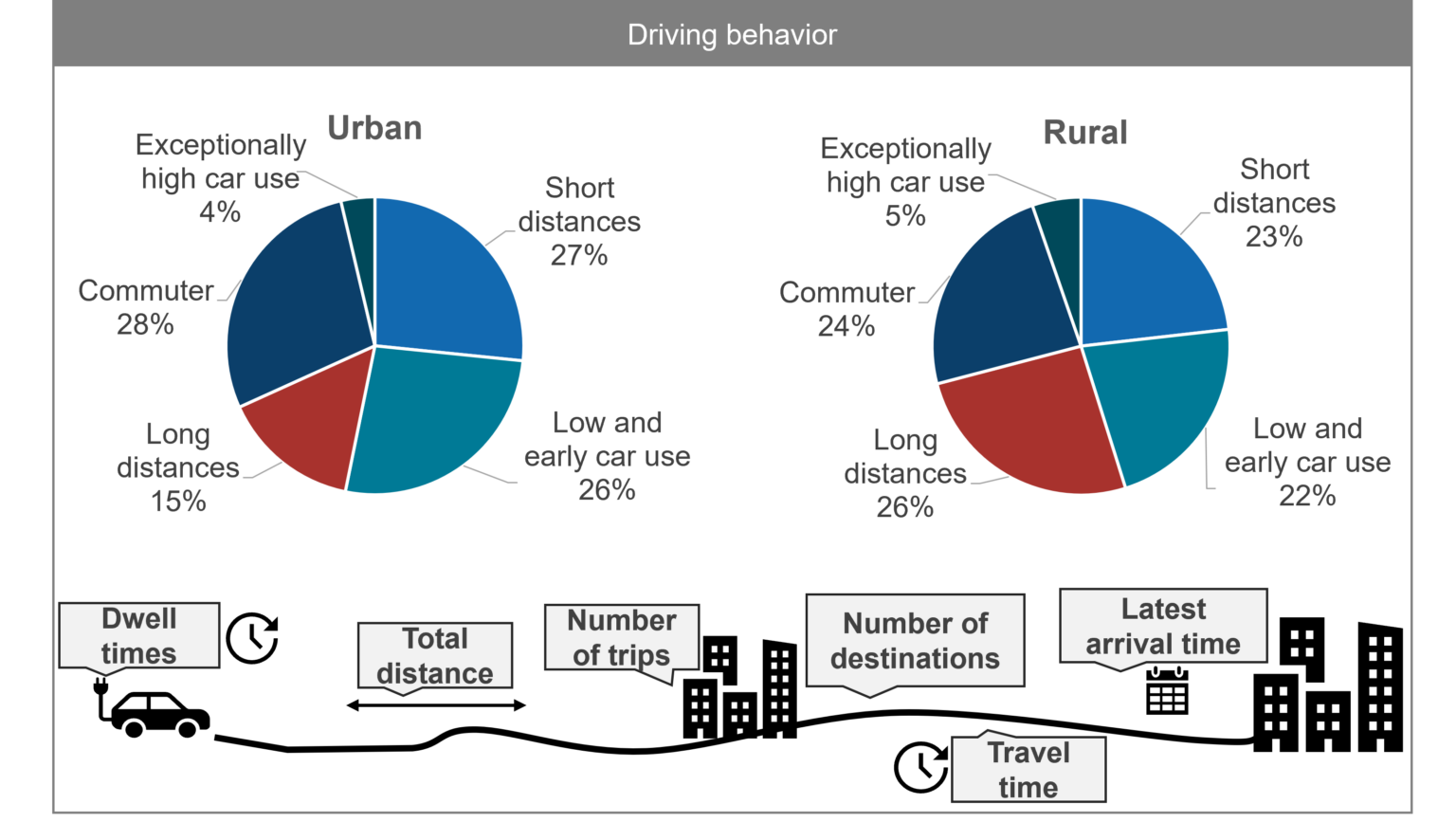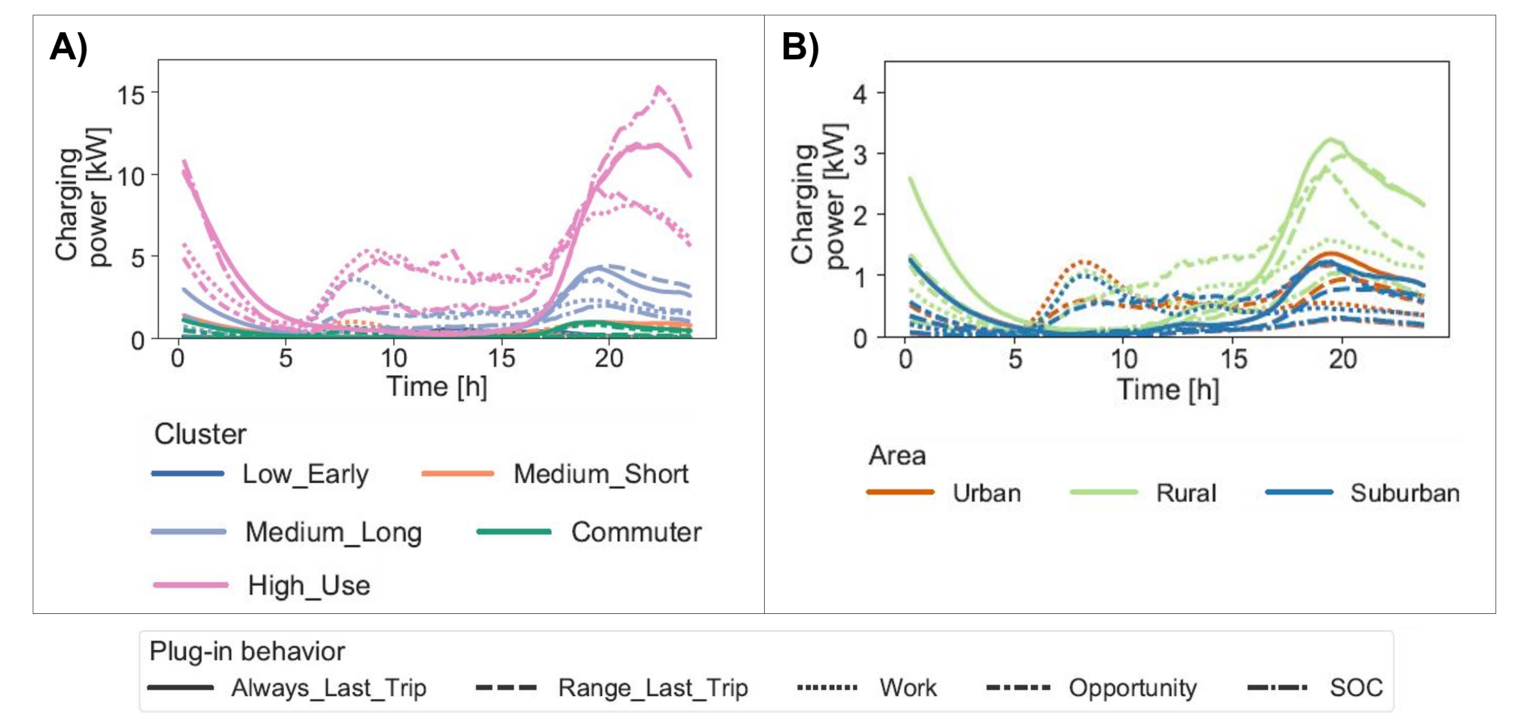
The missing piece: How diverse behaviors shape flexible electric vehicle charging
On 22.03.2023 by Christine Johanna GschwendtnerBy Christine Gschwendtner

Christine Gschwendtner has recently finished her PhD in the Group for Sustainability and Technology at ETH Zurich and is now a Postdoctoral Researcher at Harvard University. Her research focuses on how to support the adoption and integration of low-carbon technologies with focus on sector coupling and heterogeneous behavioral aspects. Current research projects investigate incentives for leveraging the spatial-temporal flexibility of electricity demand, particularly related to electrification, e.g., electric vehicles/vehicle-to-grid and heat pumps.
In an increasingly decentralized and electrified energy system, electric vehicle (EV) users and their diverse behaviors could both drastically hinder or substantially support current energy transition efforts in many regions globally. The negative or positive effect depends on how users are integrated into the system. The grid risks experiencing high peaks in electricity demand when many EV users charge their vehicles at the same time. Changes in charging behavior that shift charging to other times and places can substantially minimize grid expansion needs and balance electricity demand with variable renewable energy supply. Despite this flexibility potential, behavioral aspects of EV charging are often oversimplified or even neglected in studies and pilot projects. This blogpost discusses how different behaviors can support the integration of EVs and renewable energy.
Many discussions on EV charging are about technical aspects and costs: Can the grid handle the additional load? How much infrastructure investment is required? How can we make EVs “smart”? While all these questions are very relevant for the integration of EVs into the electricity system, one of the main actors of a successful EV integration must not be forgotten: the EV user!
EV user behavior tends to be oversimplified in studies that investigate EV charging load. The focus lies typically on technical aspects and full controllability of EV charging is assumed. This leads to substantial differences between model results and observations in real-life as behavior strongly influences EV charging. More granular consideration of diverse behaviors is required to identify suitable strategies for flexible EV integration. By providing spatial and temporal flexibility, EV users could not only support the integration of their own EV, but also ease the integration of variable renewable energy.
User behavior is very diverse
The two key behaviors relevant for flexible EV charging are driving and charging behavior. Regarding driving behavior, most commonly, people think about commuters. However, actual driving behavior in the real world is very diverse. In fact, commuters account for only 28% of drivers in urban and 24% in rural areas across the Cantons of Zurich, Freiburg, and Graubunden (see Figure 1). Other driving behaviors have similar or even higher shares, e.g., driving short distances or low and early car use. In rural areas, the share of long distance drivers is relatively high at 26%. As driving behavior determines where and when EVs are parked and hence, can be plugged into a charging station, it is essential to consider diverse driving behaviors when investigating flexible EV charging. Regarding charging behavior,key factors that influence when and where EV users charge are the state-of-charge (SOC) of the battery, the time of day, the location, and the planned travel. With the increasing adoption of EVs, the driving and charging behaviors are likely to become even more diverse. New emerging adopters, typically with different socio-demographic characteristics and different daily schedules, show diverse driving and will most likely also show diverse charging behaviors.

Figure 1: Share of driving behaviors for urban and rural areas on a typical weekday (pie charts) across the Cantons of Zurich, Freiburg, and Graubunden and characteristics used for clustering (bottom) (own figure). Full description of driving behaviors: Gschwendtner et al.
In two recent studies, we investigate the impact of diverse driving and charging behaviors on EV charging loads and their flexibility in different urban, suburban, and rural areas. To account for the diversity in behavior, we split charging behavior into plug-in behavior and charging processes. Why? Because these two elements have contrasting characteristics: The plug-in behavior refers to connecting the EV with a charging station at the beginning of a parking time, followed by the charging process within a specific parking time. Consequently, the plug-in behavior can shift charging across parking times, influencing the shifting in both time and space. In contrast, charging processes can only influence the time of charging. The plug-in behavior depends much more on behavioral aspects, i.e., where and when an EV user decides to plug-in their car. In contrast, the charging process, once it has been adopted by the EV user, is mostly automated, with minimum interaction of EV users. By identifying how much flexibility results from changes in plug-in behavior versus the automated charging process at different EV diffusion stages, suitable charging strategies for different areas can be developed and incentivized accordingly.
To capture diverse charging behaviors, we analyzed several plug-in behaviors, including charging at work (‘Work’ in Figure 2), whenever possible (‘Opportunity’), or when the SOC falls below 30% (‘SOC’). Investigated charging processes include charging during midday to integrate PV supply or avoiding charging during hours of peak electricity demand. The different charging processes correspond to different flexibility goals in the system, e.g., reducing emissions by charging when renewable energy supply is high or reducing grid expansion needs by reducing peak demand.
How different behaviors influence the flexibility of EV charging
Here, we delve deeper into the key findings on how different behaviors affect flexible EV charging, starting with the driving behavior. Although the two driving behaviors with long distances (‘Medium_Long’ in Figure 2A) and exceptionally high car use (‘High_Use’ in Figure 2A) account for a relatively low share in the fleet (see Figure 1), they cause the highest average peak demand (Figure 2A). While changes in plug-in behavior (line styles in Figure 2) can reduce the peak demand of these driving behaviors to some extent, high energy requirements from driving long distances and relatively short dwell-times limit the charging flexibility. Consequently, these driving behaviors might cause a particularly big challenge for distribution grids where many people with these driving behaviors charge their EVs in the same local area, for example in rural areas.

Figure 2: A) Charging load of an average EV by different driving behaviors (colors), assuming 100% EV adoption. Line styles refer to different plug-in behaviors. Differences between lines of the same color show the flexibility that can result from changes in plug-in behavior. Highly used EVs result in the highest load profiles; the peak load could be reduced to some extent by changes in plug-in behavior. B) Charging load of an average EV by different areas (colors), assuming 100% EV adoption. The highest peaks occur in rural areas. Changing the plug-in behavior could decrease the peak load to the level of urban and suburban areas. Adapted from Gschwendtner et al.
Regarding charging behavior and different geographical areas, the charging load for an average EV shows the highest peak in rural areas (Figure 2B). At the same time, the impact of plug-in behavior is highest in rural areas (differences between lines of the same color; Figure 2B) compared to urban and suburban areas. The differences in charging loads between urban, suburban, and rural areas likely result from the different driving behaviors in these areas (see Figure 1). Despite higher shares of long distance drivers, changes in plug-in behavior can result in flexibility and reduce the peak substantially in rural areas, e.g., by charging at work or when the SOC falls below a threshold, e.g., 30% (Figure 2B). Reasons for that include that many people living in rural areas work in or travel to urban or suburban areas, which allows for a substantial spatial flexibility of charging.
The same charging process can have different effects on flexibility goals depending on the plug-in behavior. High dependence on plug-in behavior can make the outcome of charging processes riskier for system operators as plug-in behaviors are more difficult to control. Overall, the most beneficial combinations of plug-in behaviors and charging processes are specific to geographical areas and their flexibility needs.
Policymakers need diverse strategies to accommodate diverse user behavior
These findings show that both driving and charging behaviors can make a substantial difference for the resulting EV charging load and its flexibility, and consequently, the required strategies for flexible EV integration. The most suitable charging strategies depend on the geographical context in a specific grid area and its flexibility needs. Particularly in rural areas, high local peaks can be expected, which depend more on plug-in behavior than in urban areas. Therefore, changes in plug-in behavior show a high potential for mitigating peaks in rural areas. For instance, if EV users charge at a low state-of-charge, the peak can be reduced. It is therefore crucial to account for diverse behaviors when investigating the integration of EVs. Similarly, when incentivizing specific behaviors, economically irrational behavior based on habits or personal preferences should be considered and user attractiveness needs to be ensured.
Keep up with the Energy Blog @ ETH Zurich on Twitter @eth_energy_blog.
Suggested citation: Gschwendtner, Christine. “The missing piece: How diverse behaviors shape flexible electric vehicle charging”, Energy Blog @ ETH Zurich, ETH Zurich, March 22, 2023, https://blogt.ethz.ch/energy/behavior-ev-charging/
If you are part of ETH Zurich, we invite you to contribute with your findings and your opinions to make this space a dynamic and relevant outlet for energy insights and debates. Find out how you can contribute and contact the editorial team here to pitch an article idea!

According to common practice in power supply, “the customer is king or queen”: She or he decides when to draw how much power from the grid. The power supplier has only a few possibilities to smooth the time course of the power demand, e.g. by blocking or releasing electric boilers, heat pumps and the like by means of audio frequency ripple control.
It has been discussed before whether the EV charging times should also be controlled by the power supplier; maybe even including access to the batteries’ storage capacity while the vehicle is out of use. This might not be possible in public car parks *), but at the car owner’s domicile, I think the implementation of such systems should be taken into due consideration.
*) Although … if each car had an individual identification code that could be transmitted over the power line, even that could be feasible!
The optimization of the charging time of electric vehicles only requires an incentive to charge at the right time and a change in behavior on the part of the drivers and the charging infrastructure:
1) Time-varying fees are the new incentive
2) EV users always connect their vehicle to a charging station when it is not in use, and only allow power to flow if the price is below an agreed price threshold.
This automatically causes charging at optimal times. Why? Because cars almost always stand and don’t drive. And when they are standing, they can be connected to a charging station. Either at home or in the employer’s parking lot.